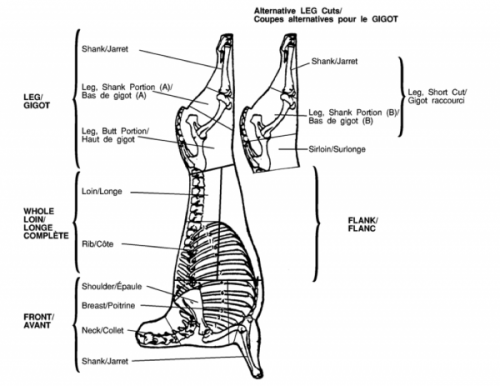Lamb refers to young male and female sheep. They are slaughtered at approximately six months of age. The lamb carcass dressed weight is usually between 25 and 27 kg (50 and 60 lb). Because it is young, lamb is very tender, promoting dry heat cooking for most of the animal. Due to the high price per pound and small carcass size, lamb is most often marketed with the bone in. Sheep over the age of 12 months is referred to as mutton. Mutton has a much stronger flavour and is less tender than lamb.

The lamb carcass (Figure 26) is broken into four primals: front, leg, loin, and flank. The lamb front is then broken into four sub-primals: the lab shoulder, neck, fore shank, and breast. The lamb leg can be left whole or split into leg shank and butt portion. The loin consists of two parts: the rib and loin. Locations of primal and cub-primal cuts of lamb are shown in Figure 27 and Table 35.

| Primal | Sub-primals |
| Leg | Shank (A),Leg, shank portion (B), Leg, butt portion (C and D), Sirloin (E) |
| Loin | Rib (rack) (G), Loin (F) |
| Flank | No further breakdown (H) |
| Front | Shoulder (J), Breast (L), Neck (I), Shank (M) |
The primals and sub-primals are further broken down into retail and restaurant cuts as shown in Table 36.
| Primal | Retail Meat Sales Cuts | Restaurant Cuts | Alternate Names |
| Lamb leg | Lamb leg shank portion | Leg of lamb | |
| Lamb leg butt portion | |||
| Lamb leg sirloin chops | Lamb sirloin (boneless) | ||
| Lamb shank | |||
| Lamb loin | Lamb loin chops | Lamb T-bone | |
| Lamb rib chops | Lamb chops | Lamb popsicles | |
| Lamb rack | Rack of lamb | Both lamb racks can be used to produce a crown roast | |
| Lamb flank | Lamb flank rolled (boneless) | ||
| Lamb shoulder | Lamb shoulder arm chops | ||
| Lamb shoulder blade chops | |||
| Lamb neck chops | |||
| Lamb shoulder roast | Lamb shoulder | Oyster shoulder | |
| Lamb shank |
Figure 28 displays retail lamb cuts. To download this poster:
 Sheep Casing
Sheep Casing Beef Casing
Beef Casing

















Reviews
There are no reviews yet.